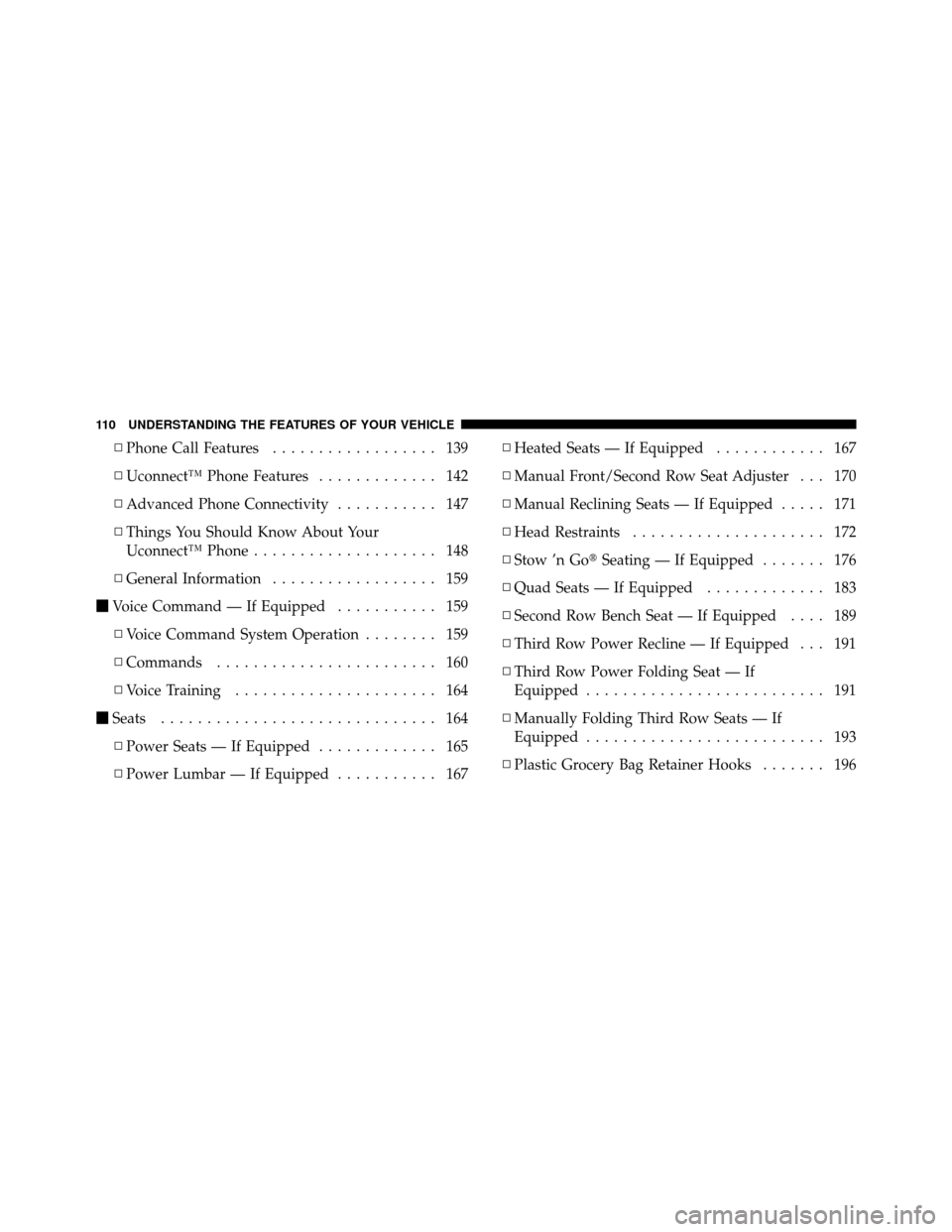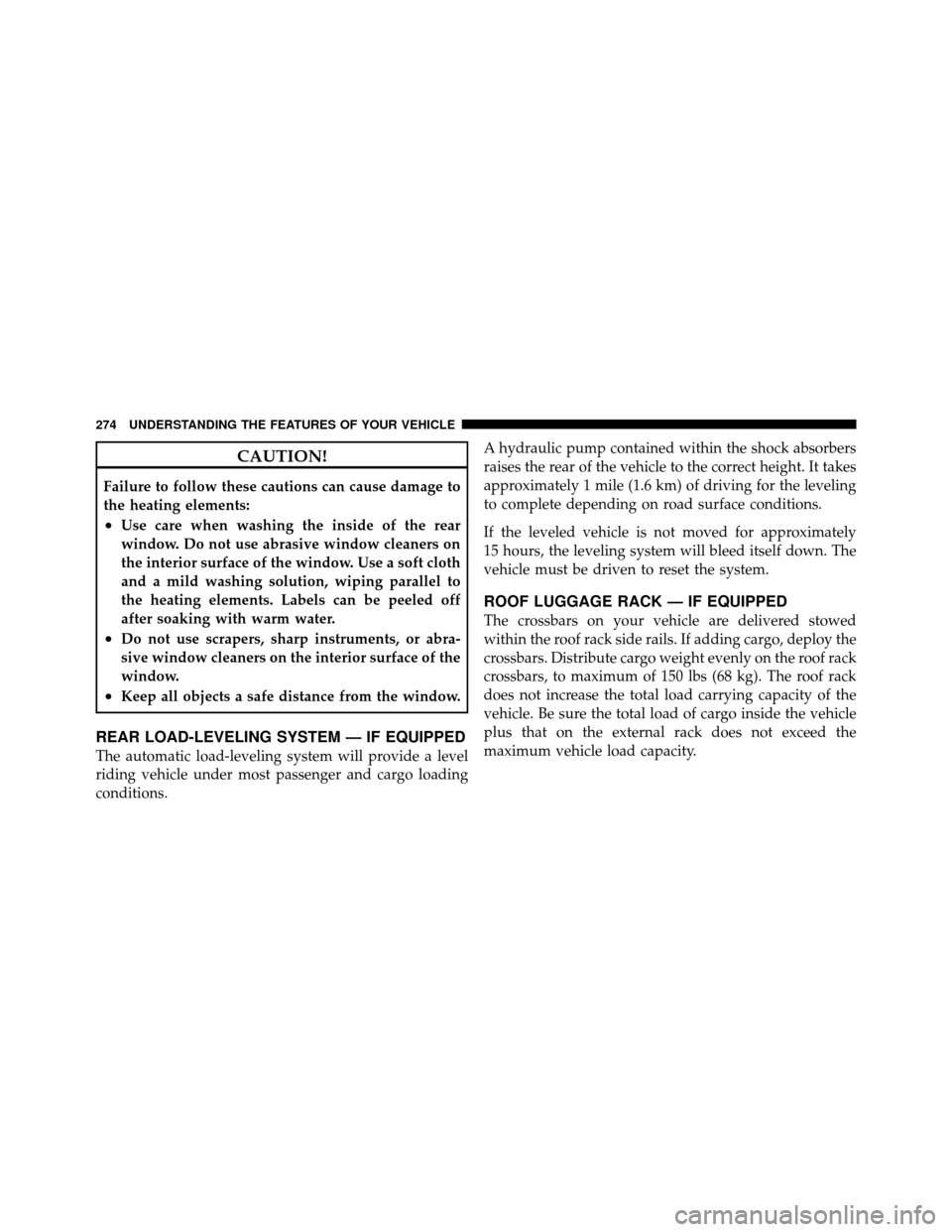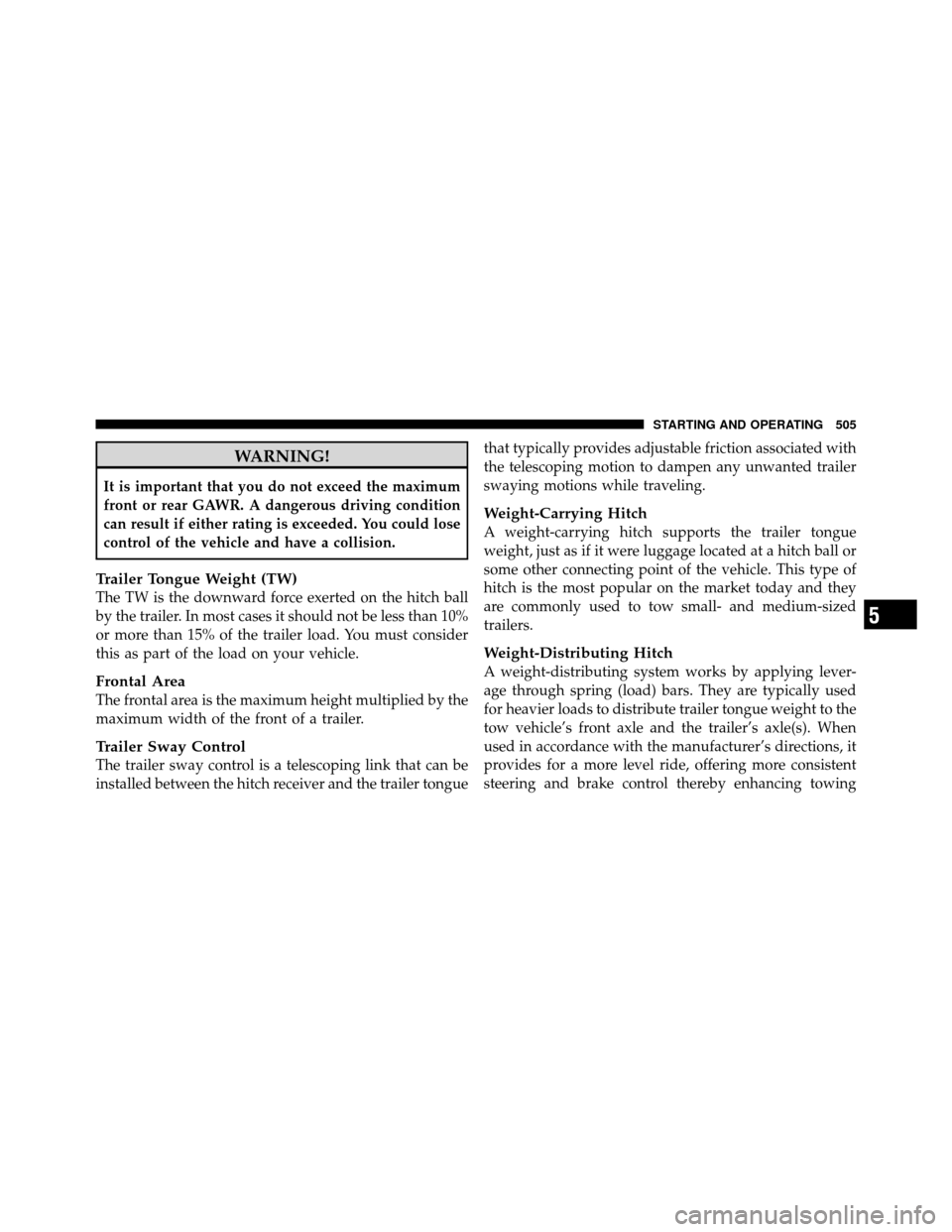Page 112 of 652

▫Phone Call Features .................. 139
▫ Uconnect™ Phone Features ............. 142
▫ Advanced Phone Connectivity ........... 147
▫ Things You Should Know About Your
Uconnect™ Phone .................... 148
▫ General Information .................. 159
� Voice Command — If Equipped ........... 159
▫ Voice Command System Operation ........ 159
▫ Commands ........................ 160
▫ Voice Training ...................... 164
� Seats .............................. 164
▫ Power Seats — If Equipped ............. 165
▫ Power Lumbar — If Equipped ........... 167▫
Heated Seats — If Equipped ............ 167
▫ Manual Front/Second Row Seat Adjuster . . . 170
▫ Manual Reclining Seats — If Equipped ..... 171
▫ Head Restraints ..................... 172
▫ Stow ’n Go� Seating — If Equipped ....... 176
▫ Quad Seats — If Equipped ............. 183
▫ Second Row Bench Seat — If Equipped .... 189
▫ Third Row Power Recline — If Equipped . . . 191
▫ Third Row Power Folding Seat — If
Equipped .......................... 191
▫ Manually Folding Third Row Seats — If
Equipped .......................... 193
▫ Plastic Grocery Bag Retainer Hooks ....... 196
110 UNDERSTANDING THE FEATURES OF YOUR VEHICLE
Page 276 of 652

CAUTION!
Failure to follow these cautions can cause damage to
the heating elements:
•Use care when washing the inside of the rear
window. Do not use abrasive window cleaners on
the interior surface of the window. Use a soft cloth
and a mild washing solution, wiping parallel to
the heating elements. Labels can be peeled off
after soaking with warm water.
•Do not use scrapers, sharp instruments, or abra-
sive window cleaners on the interior surface of the
window.
•Keep all objects a safe distance from the window.
REAR LOAD-LEVELING SYSTEM — IF EQUIPPED
The automatic load-leveling system will provide a level
riding vehicle under most passenger and cargo loading
conditions.A hydraulic pump contained within the shock absorbers
raises the rear of the vehicle to the correct height. It takes
approximately 1 mile (1.6 km) of driving for the leveling
to complete depending on road surface conditions.
If the leveled vehicle is not moved for approximately
15 hours, the leveling system will bleed itself down. The
vehicle must be driven to reset the system.
ROOF LUGGAGE RACK — IF EQUIPPED
The crossbars on your vehicle are delivered stowed
within the roof rack side rails. If adding cargo, deploy the
crossbars. Distribute cargo weight evenly on the roof rack
crossbars, to maximum of 150 lbs (68 kg). The roof rack
does not increase the total load carrying capacity of the
vehicle. Be sure the total load of cargo inside the vehicle
plus that on the external rack does not exceed the
maximum vehicle load capacity.
274 UNDERSTANDING THE FEATURES OF YOUR VEHICLE
Page 277 of 652
The crossbars and side rails are designed to carry weight
on vehicles equipped with a luggage rack. The load must
not exceed 150 lbs (68 kg), and should be uniformly
distributed over the luggage rack crossbars.
NOTE:
•Crossbars are error-proofed and cannot be deployed or
stowed in the incorrect positions.
•To help control wind noise, stow the crossbars in the
side rails when they are not in use.
Crossbar Stowed In Side Rail
3
UNDERSTANDING THE FEATURES OF YOUR VEHICLE 275
Page 278 of 652
Deploying the Crossbars
To deploy the crossbars, completely loosen the thumb
screws at both ends of the crossbar and lift the crossbar
from its stowed position in the side rail. Repeat with
crossbar on the opposite side.CAUTION!
Use care when removing and handling the crossbars
to prevent damage to the vehicle.
Bend the crossbar supports at each end, taking care to
keep hand clear of pivoting joint. Slide the thumb screw
down.
Loosening Crossbars
276 UNDERSTANDING THE FEATURES OF YOUR VEHICLE
Page 279 of 652
Then, position the crossbars across the roof.
Stowed PositionDeployed Position
3
UNDERSTANDING THE FEATURES OF YOUR VEHICLE 277
Page 281 of 652
Stowing the Crossbars
Reverse the procedure to stow the crossbars, again,
taking care to keep hand clear of pivoting joint. Crossbars
are identical and can be stowed in either rail nest. Once
the crossbars are stowed, tighten the thumb screws
completely.NOTE:
Load should always be secured to crossbars
first, with rail tie down loops used as additional securing
points if needed. Tie loops are intended as supplemen-
tary tie down points only. Do not use ratcheting mecha-
nisms with the tie loops.
Tightening Crossbar
Rail Tie Loops
3
UNDERSTANDING THE FEATURES OF YOUR VEHICLE 279
Page 507 of 652

WARNING!
It is important that you do not exceed the maximum
front or rear GAWR. A dangerous driving condition
can result if either rating is exceeded. You could lose
control of the vehicle and have a collision.
Trailer Tongue Weight (TW)
The TW is the downward force exerted on the hitch ball
by the trailer. In most cases it should not be less than 10%
or more than 15% of the trailer load. You must consider
this as part of the load on your vehicle.
Frontal Area
The frontal area is the maximum height multiplied by the
maximum width of the front of a trailer.
Trailer Sway Control
The trailer sway control is a telescoping link that can be
installed between the hitch receiver and the trailer tonguethat typically provides adjustable friction associated with
the telescoping motion to dampen any unwanted trailer
swaying motions while traveling.
Weight-Carrying Hitch
A weight-carrying hitch supports the trailer tongue
weight, just as if it were luggage located at a hitch ball or
some other connecting point of the vehicle. This type of
hitch is the most popular on the market today and they
are commonly used to tow small- and medium-sized
trailers.
Weight-Distributing Hitch
A weight-distributing system works by applying lever-
age through spring (load) bars. They are typically used
for heavier loads to distribute trailer tongue weight to the
tow vehicle’s front axle and the trailer’s axle(s). When
used in accordance with the manufacturer’s directions, it
provides for a more level ride, offering more consistent
steering and brake control thereby enhancing towing
5
STARTING AND OPERATING 505
Page 549 of 652
TOWING A DISABLED VEHICLE
Towing ConditionWheels OFF the Ground ALL MODELS
Flat Tow NONEIf transmission is operable:
•Transmission inNEUTRAL
•25 mph (40 km/h)max speed
•15 miles (24 km)maxdistance
Wheel lift Rear
Front OK
Flatbed ALLBEST METHOD
Proper towing or lifting equipment is required to prevent
damage to your vehicle. Use only tow bars and other
equipment designed for the purpose, following equip-
ment manufacturer ’s instructions. Use of safety chains is
mandatory. Attach a tow bar or other towing device to
main structural members of the vehicle, not to bumpers
or associated brackets. State and local laws applying to
vehicles under tow must be observed. If you must use the accessories (wipers, defrosters, etc.)
while being towed, the ignition must be in the ON/RUN
position, not the ACC position.
6
WHAT TO DO IN EMERGENCIES 547